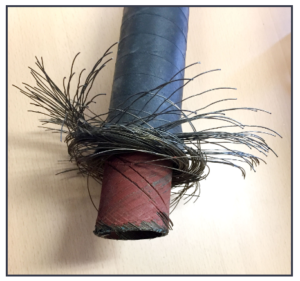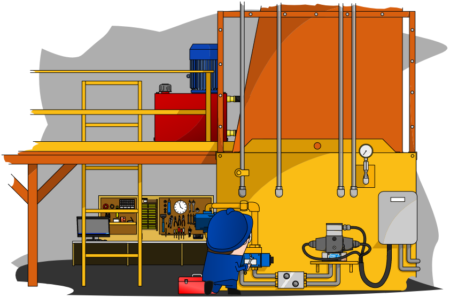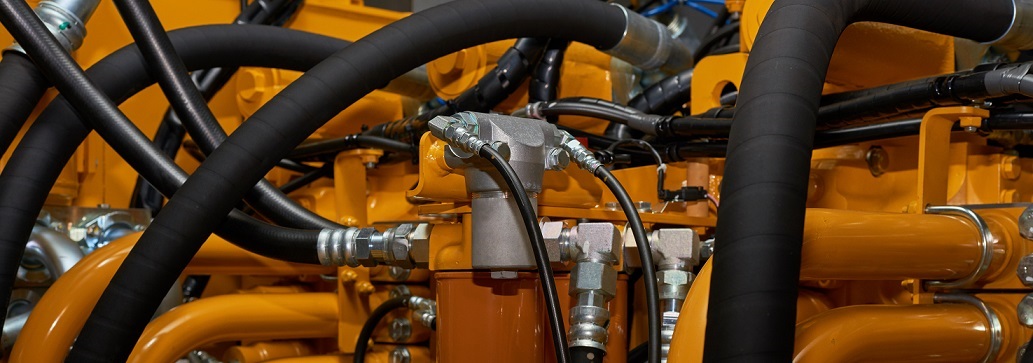How to specify the right hydraulic hose for your hydraulic system
Hydraulic hoses convey the hydraulic fluid around the hydraulic system; they are not minor accessories. Careful consideration must always be given to their specification and installation.
Why is the specification of the hydraulic hose important?
No matter how big or small, a hose burst failure on a hydraulic system is always a catastrophic incident.
The implications range from equipment failure and production downtime, through to environmental contamination concerns, to the worst-case scenario of people being seriously injured or even killed. To understand why this is the case, let’s look at some of the content provided by our friends over at LunchBox Sessions.
A word about safety
It’s simple: If you have any doubts about hoses and connectors, whether they are old or new, do not use them use them.
If you imagine a steel cable moving at high speed, you can begin to imagine the kind of damage that a hydraulic hose can do if it breaks away. When it’s filled with compressed fluid, the distance travelled and acceleration rate make the impact even harder to predict, wide-ranging and dangerous.
This is why it is absolutely essential to specify the right hydraulic hose for your application.
A failed hose looks like this (pictured). It can be replaced. Human lives can’t.

How to select the right hydraulic hose for your application
There are many factors which influence your specification of hydraulic hose, but you might find it useful to think about the following mnemonic: STAMP
S – Size: The inside and outside diameters of the hose. Plus the length.
T – Temperature: The ambient temperature and the temperature of the media being conveyed through the hose.
A – Application: The specific criteria of your particular application, e.g. routing requirements, minimum bend radius, excessive abrasion, particular requirements for weight or outside diameter (e.g. for mobile machines), compliance with industry standards, etc.
M – Media (or material): Compatibility with the fluid that is to be transmitted around your hydraulic system.
P – Pressure: The working pressure and the likelihood and extent of pressure spikes.
The working pressure and inside diameter are good starting places. A hose must be chosen with a maximum working pressure rating that is above the maximum pressure of the hydraulic system. Momentary pressure surges or pressure spikes should not exceed this rating either.
Bear in mind that the hose fittings will also need to be selected carefully to match the working pressure of the hose. If they aren’t, the entire hose assembly will need to be de-rated to the lower rating of the fittings.
A further critically important criteria is to select a hose with the correct inside diameter. The inside diameter of the hose must be large enough to accommodate the hydraulic fluid, whilst minimising pressure loss. If the diameter is too small for the flow rate of your hydraulic system, the linear velocity will be too high. This leads to problems of increased friction and turbulence – in turn creating problems of higher system pressure and heat.
Other considerations when selecting the hydraulic hose for your application
Hose length is another important consideration. An excessively long hose will add restriction to the flow – increasing system pressure and reducing system efficiency. However, the hose must allow for any bending and flexing that occurs while the system is running.
While it might be obvious that your choice of hose must be compatible with the hydraulic fluid used within your hydraulic system, you also need to consider the environment outside your system. This will affect your choice of material of the outer cover of your hose. For example, thermoplastic hoses tend to offer a higher resistance to chemicals or UV.
Where weight or space is a concern, or where your system design means a tight bend radius is necessary, it is worth considering whether you can choose a hose with a thin-wall inner tube.
Finally, you need to ensure that your system design meets any governmental and industrial standards for your application.
Tips when buying new hydraulic hose
Hose manufacturers will supply a table – or nomograph – which will help you to calculate the optimum diameter for a given flow rate and hose length.
Typically, the working pressure decreases as the hose diameter gets larger within a product line. Longer hose lengths will require a larger inner diameter to avoid excessive friction.
Tips when inspecting existing hydraulic hose
All hydraulic hoses should have essential information stamped along the outer cover in a “layline”. This will display crucial information including: the part number, pressure rating and size. Hydraulic hose laylines will also often include the name of the manufacturer and the specific product range of which the hose is part.
Examine pipe fittings and hose assemblies prior to use to ensure that burrs, dirt and/or scale are not present. Cracked, blistered or abrasion-worn hoses should never be put back into service.
All pipe and tubing ends should be reamed to prevent restriction and turbulent flow.
There are more installation tips elsewhere on our blog.
You can learn more about hydraulic hoses and other hydraulic accessories via the fantastic online content provided by LunchBox Sessions – served up in the form of bitesize lessons, videos and simulations. Some materials are accessible to all – and that’s where the images in this article have been sourced from; LunchBox Sessions have kindly allowed us to reproduce some of their e-learning content here.
We encourage you to take a look: it’s a fantastic online resource if you want to know more about how hydraulics and other industrial technologies work.
And finally, you’ll be glad to hear that a well-designed and maintained hydraulic system is perfectly safe to be and work around. Accidents are far from inevitable! Contact our award-winning team if you would like help with pioneering innovations, prototyping and product and system re-designs through to critical spares analysis, troubleshooting, equipment testing and repairs.






